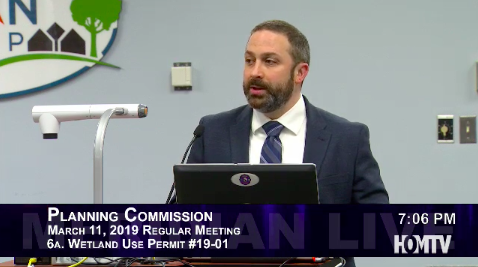
HOMTV
Meridian Township Community Planning and Development Principal Planner Peter Menser speaks to the Planning Commission about the allocation of a wetland use permit to begin the construction of a car dealership during the March 11 meeting.
The Meridian Township Planning Commission discussed a car dealership’s application for a wetland use permit during the March 11 meeting, held at 5151 Marsh Rd. All members voted to have a resolution to approve the wetland use permit at the March 25 meeting.
Request
Last year, LaFontaine Automotive Group received the Planning Commission’s approval to establish a car dealership at 1448 Grand River Ave. Today, the commission reviewed its application for a wetland use permit to fill a wetland on the easternmost parcel of the new dealership location.
LaFontaine Automotive Group requested to fill a .007-acre, 304 square feet, regulated wetland on the site.
A map, presented to the commission by Meridian Township’s Community Planning and Development Principal Planner Peter Menser, outlines the parcel of land and wetland location.
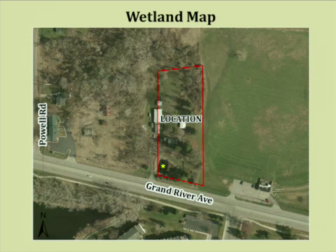
HOMTV
An outline of the easternmost parcel LaFontaine Automotive Group plans to build a car dealership on marks the wetland under review for a wetland use permit with a yellow star.
“To the east of this site is the golf-driving range which is a familiar landmark in the area,” said Menser to orient the commission and public.
Menser said the yellow star, located in the southwest corner of the site, indicates the area where there is a man-made pond.
The pond’s depth will not exceed five feet and intends to include a spillway that drains to the east, Menser said.
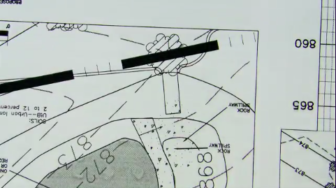
HOMTV
The map indicates the location of the replacement wetland’s spillway. The vertically oriented, white rectangular box is the wetland’s spillway. It will flow down into the wetland seen in the center bottom of the map.
Provisions
A number of procedures must be completed before a wetland permit receives approval, and work begins on the project.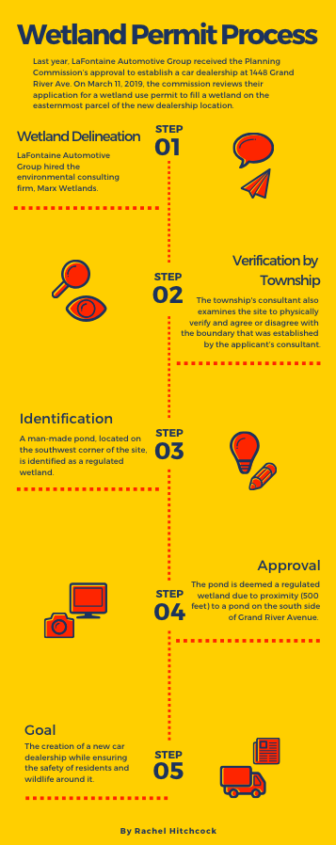
“Every time there is a wetland on a property, the general process is the applicant or property owner will hire someone to do a delineation of the property,” Menser said.
A qualified wetland scientist physically goes to the site to examine a number of factors, Menser said. Water movement, plant life and boundaries are studied and marked with a flag.
Menser said Marx Wetlands, an environmental consulting firm, delineated the wetland.
Menser said there is a two-step process that requires the applicant, and the township, to hire someone to delineate the land.
The township’s consultant examines the site compare its own measurements with that of the applicant’s delineation company.
With the applicant’s proposal request to fill the wetland to facilitate the construction of a parking lot, the township requires the creation of a replacement wetland.
“They have to create new wetland, one-and-a-half times greater than the original size, on another site on the property,” Menser said.
This provision requires the group to install a 456-foot mitigation area on the northwest corner of the site, Menser said.
The township’s wetland consultant reviewed the application and recommended issuance of the permit, Menser said.
Safety
Issuance of a wetland use permit requires the discussion of safety risks for public living around the area under examination and fish and wildlife.
The risks presented by the wetland indicate a move in favor of the relocation of the wetland to another area on the property.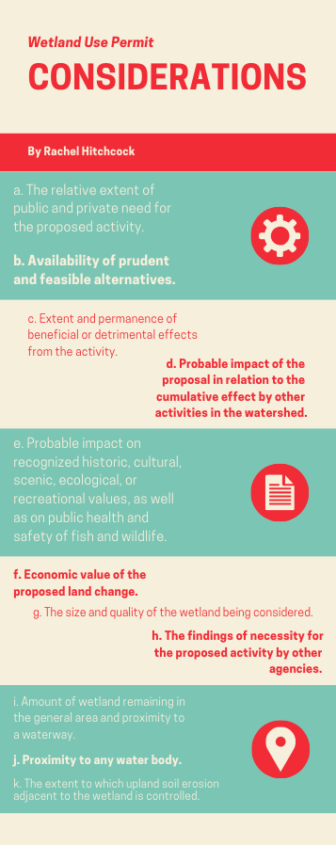
“On one hand, we think it is an approvement, and it does serve the public in this case because what we’re creating is a much nicer, regulated, larger wetland in the rear of the site where the rest of the wetland is on this property,” said Gary Laundroche, facilities director for LaFontaine Automotive Group.
If the wetland remained in its current located, Laundroche said it would be isolated with asphalt, and not be connected to other wetlands.
“I think it really turns out to be a win-win,” Laundroche said.
The applicant planned the impact from inserting the required, seven-foot sidewalk across the entire length of the development.
Laundroche said the sidewalk ends up being approximately 10 feet from the edge of the pond. This poses a health risk for both passersby that would have an increased risk of falling into the steep, gravel-filled pond, and customers walking on the site.
“The pond was going to be destroyed by one means or another, just in developing this site,” Laundroche said.
The insertion of a water main and a proposed county drain requires the wetland be dug up eventually.
“I think you’ve outlined the safety considerations, and the fact that it seems likely it was going to get disturbed by the other projects,” said Planning Commission Chair John Scott-Craig.
